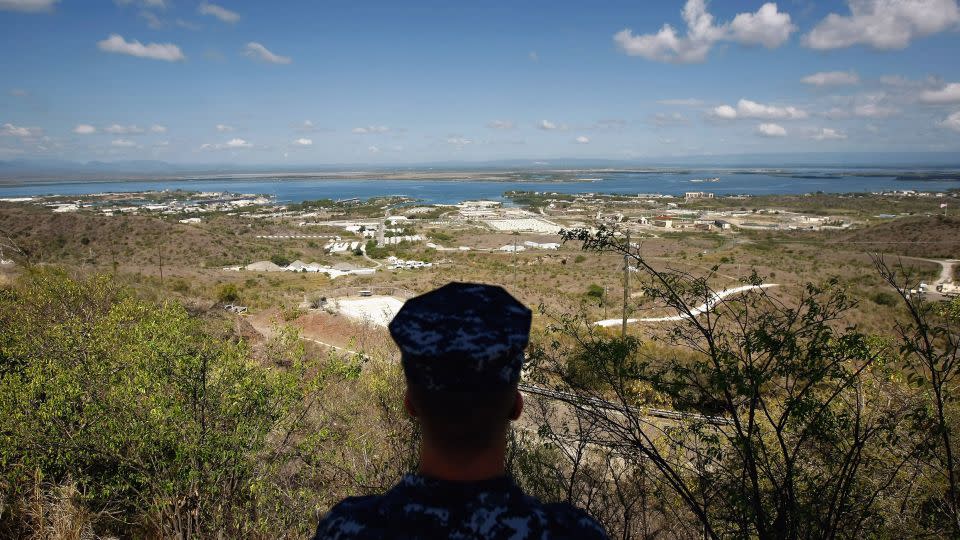Biden administration discussing using Guantanamo Bay to process possible influx of Haitian migrants

The Biden administration is discussing using Guantanamo Bay to process Haitian migrants if there is a mass exodus to the US amid worsening conditions in the country, according to a US official.
For years, Guantanamo Bay in Cuba, which is located about 200 miles from Haiti, has had a migrant center to hold and process migrants before returning them to Haiti or a third country.
The center — which is separate from where terrorist suspects are held — has been used before. In 2010, for example, the US military prepared the site in anticipation of Haitians fleeing the earthquake-stricken country.
But discussions to expand capacity at the site mark the latest sign of growing concern within the administration about people fleeing Haiti in droves as gangs attack government structures and social order is on the brink of collapse.
Migrants from Haiti would likely attempt to reach Florida by sea in a journey that can be perilous, and the US is weighing plans to take those interdicted at sea and transport them to Guantanamo for processing and potential repatriation.
“We are clear-eyed that economic, political, and security instability are key drivers for migrants around the world. We are closely monitoring the situation and the routes frequently used by migrants to reach our borders and at this time, irregular migration flows through the Caribbean remain low,” a National Security Council spokesperson told CNN.
A Homeland Security spokesperson said that so far, migration from the Caribbean remains low.
“DHS is monitoring the situation in Haiti and coordinating closely with the State Department and international partners. At this time, irregular migration flows through the Caribbean remain low,” the spokesperson said.
“Those interdicted at sea are subject to immediate repatriation pursuant to our longstanding policy and procedures. The United States returns or repatriates migrants interdicted at sea to The Bahamas, Cuba, the Dominican Republic, and Haiti,” the spokesperson added.
Haiti’s government has been under a state of emergency since groups attacked the country’s largest prison in Port-au-Prince earlier this month, killing and injuring police and prison staff and allowing some 3,500 inmates to escape.
Gangs now control 80% of Haiti’s capital, according to United Nations estimates. The chaos has forced tens of thousands to flee their homes, adding to the more than 300,000 already displaced by gang violence.
As the situation deteriorates, the United States deployed a Marine Fleet-Anti-terrorism Security Team (FAST) to Haiti to support security at the US embassy in Port-au-Prince after non-essential personnel were evacuated over the weekend.
And earlier this week, the embattled prime minister of Haiti, Ariel Henry, said he will resign, paving the way toward a political transition in Haiti that the US, among others, had pushed for.
But amid the uncertainty in Haiti, Biden administration officials are bracing for a mass migration event at a time when federal resources are already strapped, and key immigration agencies are low on funds.
Immigration and Customs Enforcement, for example, has drafted contingency plans to cut detention capacity and release thousands of migrants unless they get additional funds. They would likely have to provide personnel who have already been diverted to assist along the US southern border.
The Department of Homeland Security has been dusting off mass migration event plans, as they’ve done before with Haiti, including in 2022 as the number of Haitians interdicted at sea ticked up.
On Tuesday, Defense Department and military officials told Congress that the department is doing “a number of things to ensure we’re keeping track of” a potential mass migration from Haiti.
“I think that we need to be postured appropriately for that, exactly what you’re talking about. And I have put in a request for increased capability to do exactly that. And we are ready if a mass migration — if we need to deal with a mass migration. We did a full walkthrough of our contingency plan on Gitmo last summer with all of the interagency and all of my components,” US Southern Command Commander Gen. Laura Richardson told lawmakers.
Rebecca Zimmerman, the official performing the duties of the Assistant Secretary of Defense for Homeland Defense and Hemispheric Affairs, said that so far, the administration has “not yet seen large numbers, what we would characterize as a maritime mass migration.”
Maritime migration presents its own unique challenges and involves US Customs and Border Protection Air and Marine Operations, the US Border Patrol and Coast Guard, among others, coordinating to interdict migrants who are often taking the dayslong journey in makeshift vessels.
The agencies work together to identify and interdict migrants so they may be repatriated. If migrants make landfall, they’re brought into Border Patrol custody.
Border authorities in southern Florida are monitoring the situation in Haiti and preparation is underway in the event of an influx of Haitians arriving, according to a US Customs and Border Protection official. In the past, more than 100 people amassed on vessels for the dangerous journey by sea.
Immigration enforcement agencies within the Department of Homeland Security continue to face a budget shortfall in the absence of supplemental funding. Last year, the White House asked Congress for around $14 billion in additional funds to secure the US-Mexico border as part of a broader national security supplemental request.
President Joe Biden has repeatedly implored lawmakers to pass the request but faced challenges in the Republican-controlled House. The request remains stalled in Congress.
CNN’s Haley Britzky contributed reporting.
For more CNN news and newsletters create an account at CNN.com


